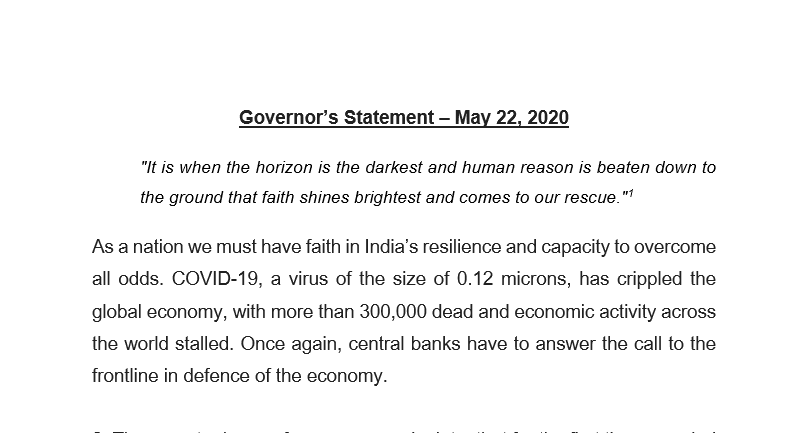Measures Taken by RBI to Improve the Functioning of Markets and Market Participants
Due to the COVID-19 epidemic, the Global economy has crippled, with more than 3,00,000 deaths and economic activities across the world stalled. Once again, central banks have to answer the call to the frontline in defense of the country.
The Marginal Standing Facility (MSF) rate and the Bank rate stand reduced to 4.25% from 4.65%. The reverse repo rate stands reduced to 3.35% from 3.75%.
The global manufacturing purchasing managers index (PMI) contracted to an 11-year low in April 2020. The global services PMI recorded its steepest decline in the history of the index. Among advanced economies (AEs) that have released GDP readings for Q1: 2020, contractions were in the range of 3.4 percent to 14.2 percent (q-o-q, annualized); for emerging market economies (EMEs), the growth rate ranged between 2.9 percent and (-) 6.8 percent (year on year basis). EMEs face additional pressures in the form of capital outflows and asset price volatility from the bouts of turbulence afflicting financial markets.
According to the United Nations Conference on Trade and Development (UNCTAD), the value of global trade contracted by 3.0 percent in Q1:2020. The volume of world trade can shrink by 13-32 percent in 2020, as projected by the World Trade Organization (WTO). World services trade deteriorated in the first quarter of 2020 due to a broad-based loss of momentum in passenger air travel, container shipping, financial, and ICT services.
Domestic economic activity has been impacted severely by the 2 months lockdown. The top 6 industrialized states that account for about 60 percent of industrial output are largely in red or orange zones. High-frequency indicators point to a collapse in demand beginning in March 2020 across both urban and rural segments.
In the production sectors, industrial production shrank by close to 17 percent in March 2020, with manufacturing activity down by 21 percent. The output of core industries, which constitutes about 40 percent of overall industrial production, contracted by 6.5 percent. The manufacturing PMI for April recorded its sharpest deterioration to 27.4, spread across all sectors. The services PMI plunged to an all-time low of 5.4 in April 2020.
Electricity and petroleum products consumption – indicators of day to day demand – have plunged into steep declines. The double whammy in terms of losses of both demand and production has, in turn, taken its toll on fiscal revenues.
In the external sector, India’s merchandise exports and imports suffered their worst slump in the last 30 years as COVID-19 paralyzed world production and demand. India’s merchandise exports plunged by 60.3 percent in April 2020 while imports contracted by 58.6 percent. The trade deficit narrowed to US$ 6.8 billion in April 2020, lowest since June 2016.
The MPC is of the view that that the macroeconomic impact of the pandemic is turning out to be more severe than initially anticipated. Beyond the destruction of economic and financial activity, livelihood and health are severely affected.
The various regulatory and developmental measures being announced today to complement and amplify the reduction in the policy rate decided by the MPC.
In the meantime, monetary policy transmission to banks’ lending rates has continued to improve. The 1-year median marginal cost of funds-based lending rate (MCLR) declined by 90 bps (February 2019-May 15, 2020). The weighted average lending rate (WALR) on fresh rupee loans has cumulatively declined by 114 bps since February 2019, of which 43 bps decline occurred in March 2020 alone.
Read the Full Statement:

 ConsultEase Administrator
ConsultEase Administrator
Consultant
Faridabad, India
As a Consultease Administrator, I'm responsible for the smooth administration of our portal. Reach out to me in case you need help.







